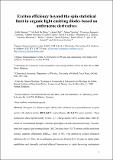Exciton efficiency beyond the spin statistical limit in organic light emitting diodes based on anthracene derivatives
View/
Date
28/01/2020Author
Grant ID
RPG-2016-047
EP/P010482/1
EP/P010482/1
703387
799302
Metadata
Show full item recordAbstract
We report two donor-acceptor (D-A) materials based on a cyanoanthracene acceptor paired with diphenylamine ( DPAAnCN ) and carbazole ( CzAnCN ) donor moieties. These compounds show hybrid locally excited (LE) charge-transfer (CT) excited states (HLCT), which we demonstrated through a combined photophysical and computational study. Vacuum- deposited organic light emitting diodes (OLEDs) using these HLCT emitters exhibit maximum external quantum efficiencies (EQEmax) close to 6%, with impressive exciton utilization efficiency (Φs) of >50%, far exceeding the spin statistic limit of 25%. We rule out triplet-triplet annihilation and thermally activated delayed fluorescence as triplet harvesting mechanisms along with horizontal orientation of emitters to enhance light outcoupling and, instead, propose a “hot exciton” channel involving the nearly isoenergetic T2 and S1 states.
Citation
Sharma , N , Wong , M Y , Hall , D , Spuling , E , Tenopala Carmona , F , Privitera , A , Copley , G J , Cordes , D B , Slawin , A M Z , Murawski , C , Gather , M C , Beljonne , D , Olivier , Y , Samuel , I D W & Zysman-Colman , E 2020 , ' Exciton efficiency beyond the spin statistical limit in organic light emitting diodes based on anthracene derivatives ' , Journal of Materials Chemistry C , vol. In press . https://doi.org/10.1039/C9TC06356K
Publication
Journal of Materials Chemistry C
Status
Peer reviewed
ISSN
2050-7526Type
Journal article
Description
E.Z.-C. acknowledges the University of St Andrews and the Leverhulme Trust (RPG- 2016-047) for financial support. E.Z.-C. and I.D.W.S. thank EPSRC (EP/P010482/1) for support. We thank EPSRC UK National Mass Spectrometry Facility at Swansea University for analytical services. The work in Mons was supported by the European Union’s Horizon 2020 research and innovation program under Grant Agreement N°. 646176 (EXTMOS project). Computational resources have been provided by the Consortium des Équipements de Calcul Intensif (CÉCI), funded by the Fonds de la Recherche Scientifiques de Belgique (F.R.S.- FNRS) under Grant No. 2.5020.11. C.M. and G.C acknowledge funding by the European Commission through a Marie Skłodowska Curie fellowship (No. 703387 and 799302, respectively). M.C.G. acknowledges funding from EPSRC (EP/R010595/1). A.P. acknowledges the European Union’s Horizon 2020 research and innovation programme under Marie Sklodowska Curie Grant agreement No. 722651 (SEPOMO project). EPR measurements were performed in the Centre for Advanced ESR (CAESR), located in the Department of Chemistry of the University of Oxford, and this work was supported by the EPSRC (EP/L011972/1).Collections
Items in the St Andrews Research Repository are protected by copyright, with all rights reserved, unless otherwise indicated.

